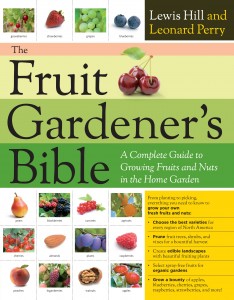 A Gardener’s Reading, 27 of 30
A Gardener’s Reading, 27 of 30
By Lewis Hill and Leonard Perry (Storey Publishing, 2011)
I just received this book, so this is really more of a first impression than a full-fledged review, but I am eager to get into this manual on growing fruits, which was originally published in 1992 as Fruits and Berries for the Home Garden.
Except for raspberries, I find growing fruits challenging. In Minnesota, apples are tough to grow organically, my preferred method. Blueberries demand an acid soil that I have not been able to concoct, despite several efforts. (I may make one more this year in a bed near some pine trees.) I’ve had decent luck with sour cherries, and have been told that currants would grow well in my yard. Still, fruit is something my family loves, and I would like to grow more of it, and to grow what I do more carefully.
The Fruit Gardener’s Bible is a detailed overview of how to grow a large variety of fruits. After covering the basics of soil, sun and site, the authors start with the easiest fruits to grow—raspberries and strawberries—and move on from there. Each section gives details on how to plant, prune, maintain and harvest the fruits, as well as fairly extensive discussions of diseases and insects and how to prevent or control them. The authors also recommend varieties for different climates, which is extremely helpful in a book that is geared for a national audience. I sadly skipped over the section on peaches and nectarines, which cannot be grown in Minnesota.
After a first pass through the book, I discovered that my apples have something called “bitter pit” and that I might be smarter to plant lingonberries than blueberries in the acidified soil near one of our conifers. I also found the “Checklist of Activities for Fruits and Nuts” helpful, in that it lays out a yearly schedule of what to do. I expect this is a book I’ll be nipping in and out of all summer.
Leave a Reply